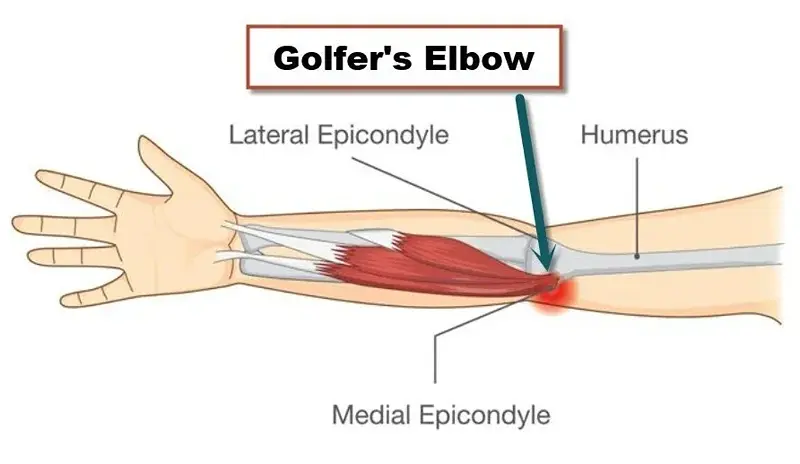Golfer’s Elbow (Medial Epicondylitis) at DRHC Dubai Sports Injuries Clinic
Overview
Golfer’s Elbow, medically known as Medial Epicondylitis, is a common condition that causes pain and inflammation in the tendons that connect the forearm muscles to the inner side of the elbow. Despite its name, this injury is not limited to golfers; it can affect anyone who performs repetitive motions involving the wrist and forearm. Sports like tennis, baseball, and weightlifting, as well as certain occupational activities, can also lead to Golfer’s Elbow. It is characterized by pain, weakness, and stiffness in the elbow and forearm, impacting an individual's ability to perform daily activities or sports.
Symptoms of Golfer's Elbow:
- Pain and tenderness: The primary symptom is pain on the inner side of the elbow, which may extend along the inner forearm. Pain usually worsens with specific movements, such as gripping or flexing the wrist.
- Stiffness: The affected elbow may feel stiff, making it difficult to bend or straighten the arm.
- Weak grip strength: You may notice weakness when trying to grip or lift objects, which can affect sports performance or everyday tasks.
- Numbness or Tingling: In some cases, numbness or tingling may radiate into the fingers, especially the ring and little fingers.
- Worsening pain with activity: Repetitive motions, like swinging a golf club, throwing a ball, or even typing, can exacerbate the pain.
Causes of Golfer's Elbow:
Golfer’s Elbow is primarily caused by overuse and repetitive stress on the tendons that control wrist and finger movements. Risk factors include:
- Repetitive movements: Sports or activities involving repeated wrist flexion, gripping, or forearm twisting can overload the tendons in the elbow.
- Improper technique: Using incorrect form or posture during sports or physical tasks can put excessive strain on the elbow joint.
- Lack of conditioning: Inadequate warm-ups, insufficient flexibility, or weak forearm muscles can increase the risk of developing Golfer’s Elbow.
- Occupational hazards: Jobs that involve repetitive motions, such as carpentry, painting, or assembly line work, can lead to medial epicondylitis.
Diagnosis of Golfer's Elbow:
At DRHC Dubai, diagnosing Golfer’s Elbow involves a combination of:
- Physical examination: Your doctor will assess your elbow, forearm, and wrist movements to pinpoint the location and severity of pain.
- Range of motions tests: You may be asked to perform specific movements to determine how the elbow is functioning and identify any restrictions.
- Imaging tests: In some cases, X-rays or an MRI may be ordered to rule out other conditions, such as fractures or nerve compression, and to assess the extent of tendon damage.
Treatment for Golfer's Elbow:
Treatment options at DRHC Dubai aim to reduce pain, promote healing, and restore strength to the elbow. These include:
- Rest and activity modification: Avoiding or reducing activities that trigger pain is crucial for healing. Resting the affected arm and modifying daily activities can prevent further damage.
- Ice Therapy: Applying ice packs to the elbow can reduce inflammation and alleviate pain.
- Physical therapy: A tailored rehabilitation program will include stretching and strengthening exercises for the forearm, wrist, and elbow muscles to promote healing and prevent recurrence.
- Anti-inflammatory medications: Over-the-counter or prescribed medications can help manage pain and inflammation.
- Bracing or Splinting: Using a wrist or elbow brace can provide support and reduce strain on the affected tendons.
- Corticosteroid injections: In cases of severe pain or inflammation, your doctor may recommend injections to reduce swelling and relieve symptoms.
- Shockwave therapy: This non-invasive treatment uses sound waves to stimulate tendon healing and can be an effective option for chronic cases.
- Platelet-rich plasma (PRP) therapy: PRP injections use your body’s platelets to promote healing in the damaged tendons.
- Surgical interventions: If conservative treatments fail and symptoms persist, surgery may be considered to remove damaged tissue and repair the tendon.
Prevention Tips for Golfer’s Elbow:
Athletes and individuals can take steps to prevent Golfer’s Elbow by:
- Proper warm-up and stretching: Warm up with dynamic stretches before any activity, focusing on the forearm, wrist, and elbow muscles.
- Strength training: Strengthen the forearm and wrist muscles to provide better support and prevent overuse injuries.
- Use proper technique: Learning and maintaining the correct form in sports and activities can significantly reduce strain on the elbow.
- Gradual increase in intensity: Avoid sudden increases in physical activity levels, especially in sports that involve repetitive arm movements.
- Ergonomic adjustments: In the workplace, ensure that tools and equipment are ergonomically designed to reduce stress on the elbows and wrists.
Why Choose DRHC Dubai for Golfer's Elbow Treatment?
At DRHC Dubai, our sports injury specialists are experienced in diagnosing and treating Golfer’s Elbow and other overuse injuries. We provide personalized treatment plans that are designed to address the specific needs of athletes and active individuals. Whether through conservative treatments or advanced therapies, our goal is to help you recover quickly and return to your favorite sports and activities pain-free.
.png?width=281&height=59&name=bookanappointment%20(1).png)
Are you looking for the best orthopedic doctor in Dubai or a neuro-spinal hospital? provides the best orthopedic surgeon in DRHC Dubai. Call +97142798200 to Schedule Your Appointment Today.




.png?width=281&height=59&name=bookanappointment%20(1).png)




